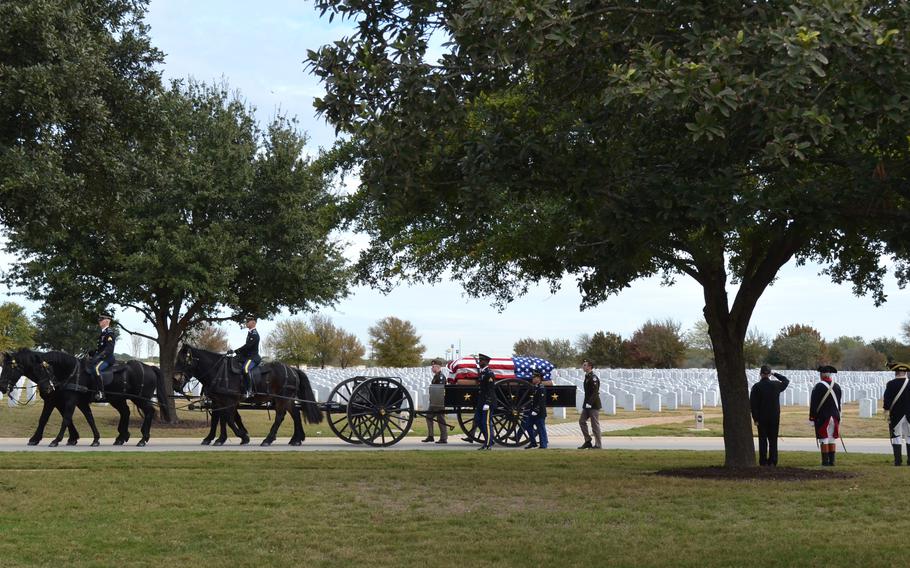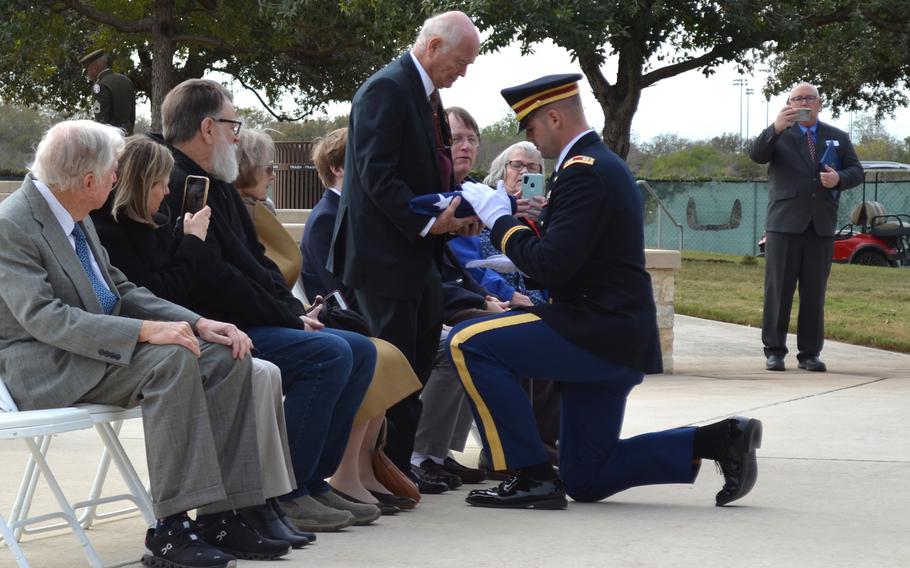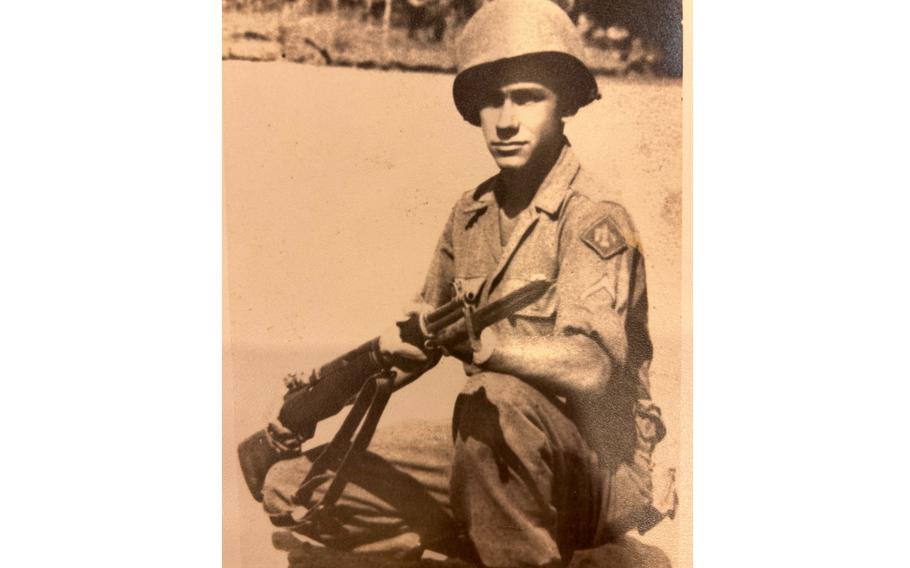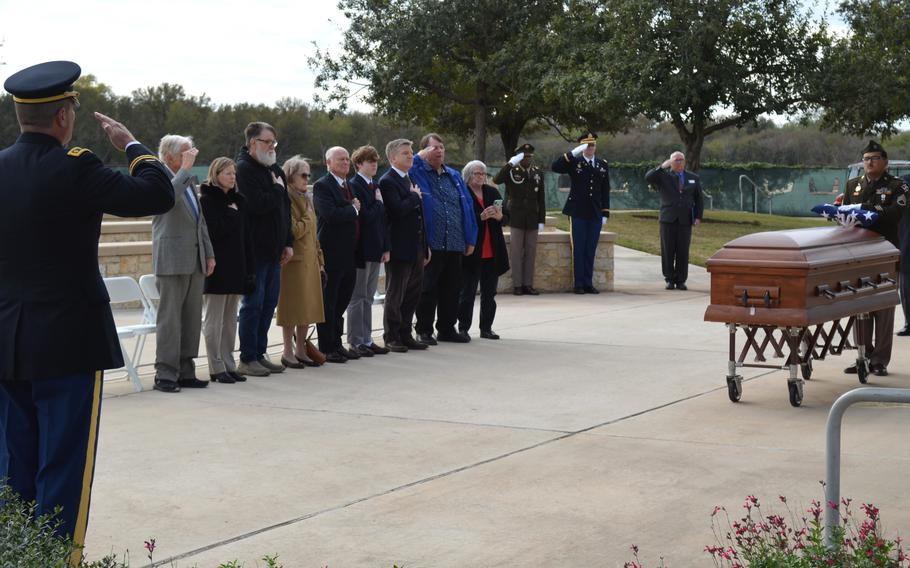
Members of the Military Funeral Honors-Caisson Platoon from Joint Base San Antonio-Fort Sam Houston deliver the remains of Pfc. Clinton Edward Smith to Fort Sam Houston National Cemetery in San Antonio, Texas, on Nov. 27, 2023. Smith died in combat in Reipertswiller, France, during World War II on Jan. 14, 1945. The Defense POW/MIA Accounting Agency identified Smith’s remains last year. (Rose L. Thayer/Stars and Stripes)
FORT SAM HOUSTON, Texas — Pfc. Clinton Edward Smith left behind his music studies at Baylor University in Waco, Texas, to enlist in World War II.
The musician in him persisted, and Smith found himself playing “Lili Marlene” on a battered piano on a beachhead in Anzio, Italy, “with German artillery shells supplying the bass,” he told his local newspaper, the Corpus Christi Caller-Times.
The report was published May 20, 1945, about four months after Smith was struck by shrapnel and killed in France during an attempt by German forces to break the American front line. He was 19 years old when he died, and it took 77 years to bring him to rest.
The Defense POW/MIA Accounting Agency, or DPAA, identified Smith’s remains last year from a group of unknown soldiers buried in Belgium. Smith, who was known in his family as Ed, was buried Monday with full military honors at Fort Sam Houston National Cemetery in San Antonio.

Doug Smith accepts a folded flag during the funeral service of his uncle, Pfc. Clinton Edward Smith, at Fort Sam Houston National Cemetery in San Antonio, Texas, on Nov. 27, 2023. (Rose L. Thayer/Stars and Stripes)
Doug Smith, the soldier’s 84-year-old nephew, said his uncle’s service — or that he hadn’t made it home — was not discussed much within the family, but he’s been amazed to learn the history during the past year.
Information provided by DPAA exposed the hidden pain of the soldier’s parents, which was laid out in nearly 20 pages of correspondence between them, the Army and recovery teams as the couple pushed for answers that would not come in their lifetime.
“It must have hit them hard,” Doug Smith said. “The process of finding him was just a miracle.”
Ed Smith was one of three brothers, all of whom served during World War II, Doug Smith said. Ed was the only brother who did not return home.
He enlisted in the Army on Jan. 6, 1944, and just a few months later fought on the beaches of Anzio with Company D, 1st Battalion, 157th Infantry Regiment, 45th Infantry Division, according to DPAA.

Pfc. Clinton Edward Smith enlisted in the Army in January 1944 and died in combat in Reipertswiller, France, during World War II on Jan. 14, 1945. The Defense POW/MIA Accounting Agency recently identified Smith’s remains. (Photo provided by Martita Fleming)
From Anzio, Smith took part in the campaign to Rome and the invasion of France.
On Jan. 14, 1945, Smith was hit by shrapnel while manning his machine gun in Reipertswiller, France, and died. The battle was part of Germany’s final push to break American lines, known as Operation Northwind.
Because the Germans controlled the territory where Smith fell, his fellow soldiers were unable to recover his body.
His remains were later found by a resident in Reipertswiller and buried as an unknown soldier at Henri-Chapelle American Cemetery, an American Battle Monuments Commission site in Belgium, said Carrie Brown, laboratory manager for DPAA at Offutt Air Force Base in Nebraska.
Originally, 15 service members were missing from that battle, according to DPAA. To date, eight have been identified.

The family of Pfc. Clinton Edward Smith stands to honor the fallen soldier during a funeral service at Fort Sam Houston National Cemetery in San Antonio, Texas, on Nov. 27, 2023. (Rose L. Thayer/Stars and Stripes)
Across the entirety of the war, DPAA has accounted for 1,543 missing service members. More than 72,000 remain missing.
Smith’s remains were removed from the Belgium cemetery in August 2021. DPAA scientists then used DNA, dental records and personnel records — including those letters his parents wrote after the war — to identify his remains.
“The personnel records help us support the circumstances of loss, and help us support things like height and age,” Brown said. “That’s an amazing thing to think about the impact that this loss is having because it’s still felt decades and generations later. And there it is in that letter.”
Doug Smith said he wished his father and the other relatives who knew his uncle were alive to see him returned home Monday. During the service, he sat among his cousins as a horse-drawn caisson brought Ed Smith’s flag-draped casket toward the small gathering of people there to honor the soldier.
“If he had just made it another two or three months, it was all over,” Doug Smith said. “He was such a young man going over there to fight at 19 years old.”